Few materials embody human experience as naturally as clay. In its malleable state, clay is fleshly, easily wounded but easily healed. Fired, it ossifies. Surface glazes pool and congeal like bodily fluids. Priceless porcelain masterpieces and preschoolers’ art projects attest that the urge to mold clay figures transcends age and class. No wonder people throughout time across the globe have recorded their undergoings in pliable earth. Advancing this age-old tradition, Craft Contemporary’s second clay biennial, “The Body, The Object, The Other,” features outstanding work by 21 contemporary artists exploring personal experiences and cultural phenomena via clay.
The show’s title alludes to three thematic threads conceived of by curators Holly Jerger and Andres Payan Estrada: all the work relates to the human body in some form; many of the artists interrogate or honor historical art objects; and many address self-image in relation to notions of the anthropological or philosophical Other. Rendered palpable in clay, specific sociopolitical issues are presented in manners readily relatable to a wide audience.
The coronavirus pandemic was undoubtedly far from the minds of the artists as they worked towards this exhibition, which opened January 25 and is currently shuttered ahead of its originally scheduled May 10 closing date. In reviews, it is typically inadvisable to broach outside events tangential to the art itself; but at the moment, microbes are the elephant in the room. The show remains inside the museum, yet nobody may see it. Everyone has a body, and everybody can relate to clay. There is dispiriting irony in the fact that these artists, many of whom come from traditionally marginalized positions, employ figures and clay as universal languages; yet their show is temporarily invisible by dint of a disease infecting bodies worldwide. Perhaps discussion in the form of a written tour may fill an iota of the void riven by the contagion that has necessitated distancing ourselves from one another and from the art that we may no longer enjoy in the flesh.
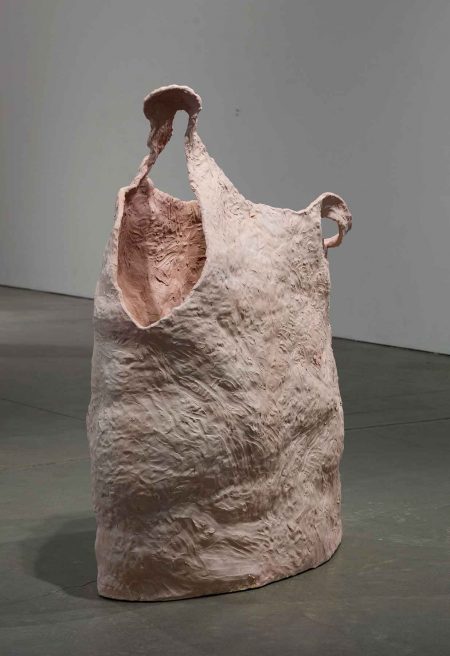
Undercurrents of existential disquiet permeate the show. Upon entering the museum, the first pieces one encounters are a trio of large-scale hand-built coil sculptures by Anabel Júarez. Their shapes vaguely resemble female torsos, bringing to mind Frida Kahlo’s plaster cast corsets. They seem meant to be worn, like mysterious beings’ exoskeletons or dresses for unseen giants. Evoking skin, textures are delicately carved and extruded like lesions or brushstrokes across their interior and exterior surfaces.

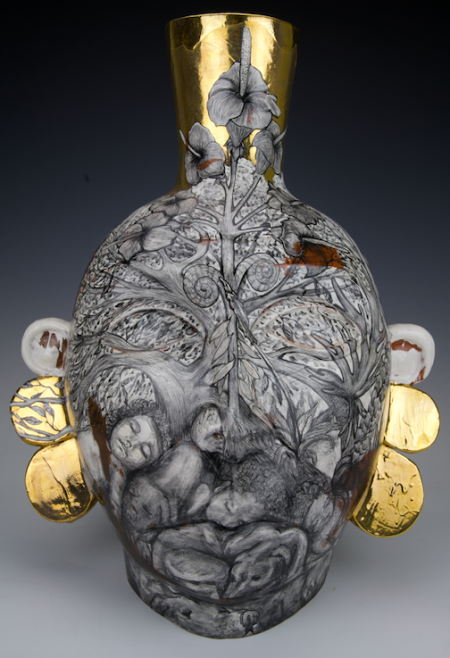

The second floor is replete with themes of history and influence. The pristine comeliness of Alex Anderson’s gilded white sculptures belies darkly charged signifiers; in How you feel though? (2019), a dainty cobra cries gold blood. Gerardo Monterrubio’s ceramics address similar themes in more overtly disturbing ways. Catholic and Mesoamerican emblems of venerability harbor sanguinary vignettes of torture, murder, and war. The Oaxaca-born artist uses an underglaze pencil to illustrate his clay surfaces; one could spend hours apprehending the detail in his flowing drawings so horrific they make one’s stomach turn. Across the room, Phyllis Green’s Odd Old Things (2009-2019) playfully questions ageism against women by recasting Degas’ ballerinas as faceless dumpy brown cartoon crones long past their graceful prime, barely even suited for use as candelabras.
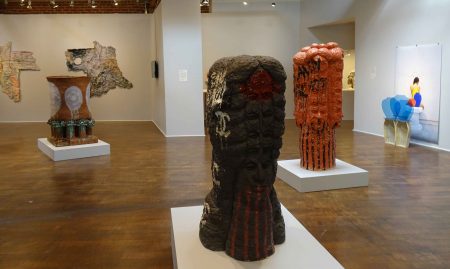
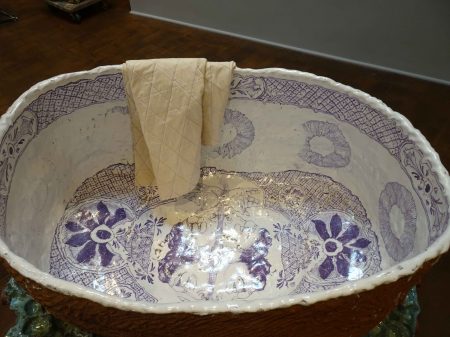
Artists exhibited on the third floor more explicitly deal with aspects of personal identity relating to gender, ethnicity, and queerness. Much of the central floor space is occupied by large-scale pieces, including Nicki Green’s transgender interpretations of Jewish ritual bathtubs, and Raven Halfmoon’s imposing head sculptures created with ceramic techniques of her native Caddo tribe. Playing on archetypes of non-human women, Roxanne Jackson’s engagingly grotesque sculptures convolute glamorous trappings of female beauty with nightmarish vestiges of beastliness. In Once More With Feeling (2018), a face devolves into purple goo below the tresses of a brunette wig.
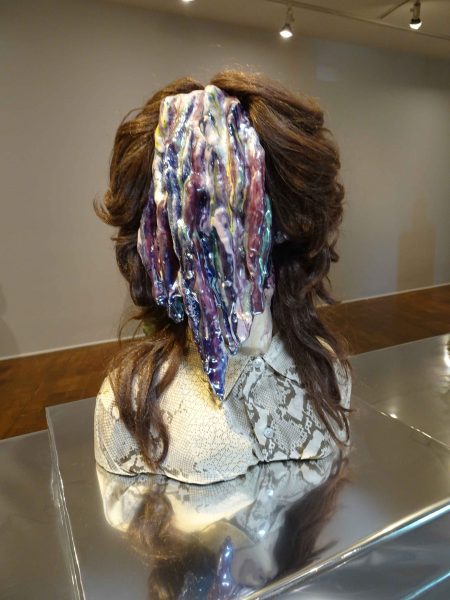


Socrates likened the soul to an impressionable block of soft wax; but he may as well have spoken of pliable earth, which potentially records the artist’s every physical motion enacted upon it, from dainty thumbprints to rough pummels. Several artists abstractly interpret the figure by employing clay to represent bodily motion. Brie Ruais’ painterly wall-hung ceramics are topographies of her movement across clay expanses. Nicole Seisler’s site-specific drawing, Preparing (2020), was accomplished by staining white walls with ruddy stains of wedged clay. In Cassils’ installation, Ghost (2012-present), one’s feet sink into moist clay substrate in a pitch-black room overlaid with a soundtrack of the artist’s Sisyphean grunts in grappling with a one-ton block of clay during a prior performance. Returning downstairs, you pass a bevy of vaguely vertebral beads of unfired clay extruded by previous visitors in Cannupa Hanska Luger’s Something to Hold Onto (2019). Typically, closed fists symbolize protest or aggression; but these casts of their negative space serve as vehicles of solidarity. A short how-to video encourages you to squeeze a clay impression of your fist and place it alongside the rest. Cloistered out of sight during this time of social distancing, the collaborative gesture of unity seems simultaneously hopeful and tragic.

Other included artists are: Jenny Hata Blumenfield, Jason Briggs, Sharif Farrag, Cynthia Lahti, Galia Linn, Anders Herwald Ruhwald, Megan Smythe, Cammie Staros, Wanxin Zhang, and Bari Ziperstein. Craft Contemporary has extended “The Body, The Object, The Other” through Sept. 13. For further information and images, see https://www.craftcontemporary.org/exhibitions/clay-biennial-2020/